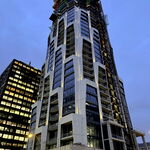If HFR happens it will be the perfect project to really start to kick start modernization and rationalization of passenger rail in The Corridor. And based on gut feeling and the reaction to it in the media (and the minimal amount of negative reaction to it) I would put the odds in favour of it at around 75%,
There are two things VIA can do to that will allow it to make the service faster, more reliable, and more appealing. The first is to run on its own dedicated network of tracks. Most don't need to be full on, whiz bang, 300km/h lines. They just need to be their own, and allow trains to operate in that 160-200km/h zone a much as possible, without worrying about freight traffic. And they need to improve their reach and come up with better ways of directly serving areas like most all of the northern GTA, Gatineau, parts of the Montreal Region, and improving access in a number of locations (in other words, differentiating how the serve people home locations at the start of their trip, and their temporary home, their destination at the end of the trip). The second one will be able to happen over time as VIA increases frequency and has more trips that it can experiment with new services on, while not being at the expense of a particular place's existing service levels. And HFR, obviously, starts to address the first issue in a pretty big way.
Everyone knows that the one section of The Corridor that can justifiably have a full HSL built is the Lakeshore corridor from Montreal to Toronto. And it will also be the most expensive section, regardless of what standard a dedicated passenger track is built to. And it will take a lot of planning. Some parts of the line might just be able to run parallel to the CN line, such as from around Coteau to close to Brockville, where the geometries are relatively straight, the land relatively flat, and densities (urban and rural) are lower than other parts of the Lakeshore line. Other parts will need a new right of way, some might use part of the 401 right of way, while others might use an old abandoned railway right of way. Just the planning of it will take some time. And right now, all VIA is doing is throwing money away on CN infrastructure every time it tries to add capacity, or even just maintain the status quo on the Lakeshore corridor. HFR allows it increase capacity from Toronto to Ottawa without burdening the corridor, maybe even freeing up an extra spot (or 2 if they are super lucky), for Toronto to Montreal service. In any event, it gives VIA a reprieve. HFR will save them what is no doubt a substantial amount of money that they would otherwise have to spend on the Lakeshore corridor, without that money resulting in any of their own infrastructure.
By the time HFR has been built, VIA will have had enough time that it could come up with a plan for its own dedicated track in the Lakeshore corridor. I would find it surprising if the line was built all at once. Instead, I could see easier sections done first (like the Coteau to Brockville section mentioned above), while negotiations and planning continue for some of the more complicated ones. The plan doesn't need to be totally finalized by the time HFR is done, but the overall vision could be in place.
HFR is probably the first plan that has been proposed by VIA, or any agency or consortium, in the past 30 years, that is actually a good plan. It isn't a compromise plan. It doesn't mean HSR will never be built (it actually strengthens the case and need for HSR, in corridors where it makes sense). It is just a brilliantly, pragmatic plan. And I am not saying that because I have the "lets just support it so that we get something, anything built, or else we will get nothing and VIA will die" mentality. This is a win for almost everyone, is good value for money, will provide faster service, improve the limited rail infrastructure VIA currently owns, and increase the length of dedicated tracks it owns by 4 or 5 fold. HFR is something that everyone needs to get behind and support as vocally as possible.
I am really looking forward to hearing that announcement this year...




